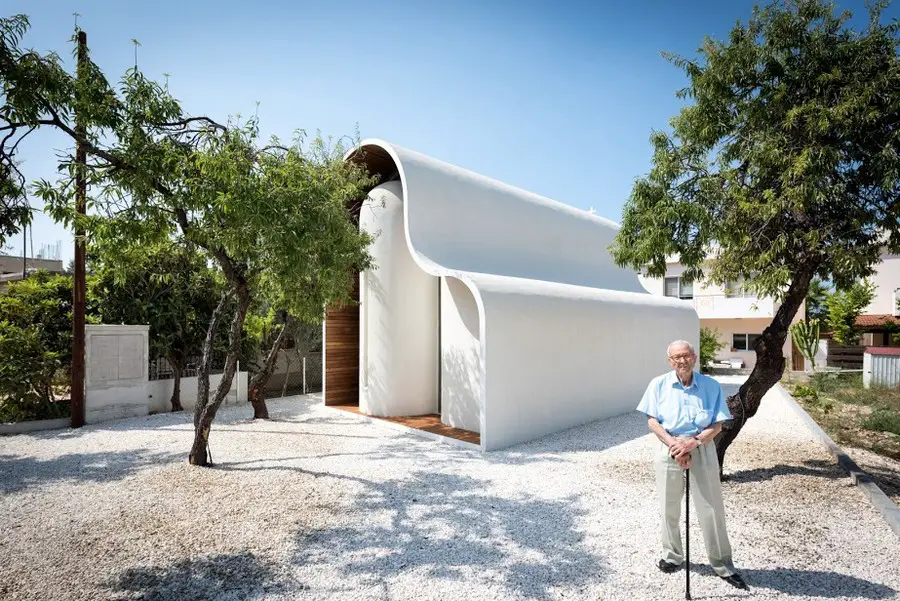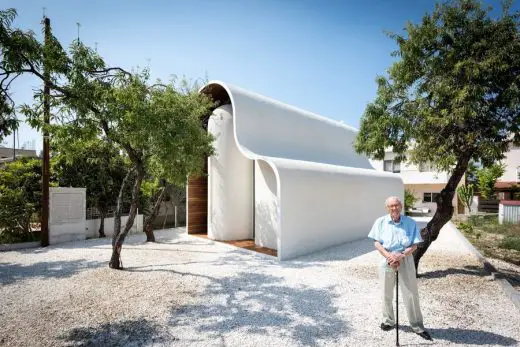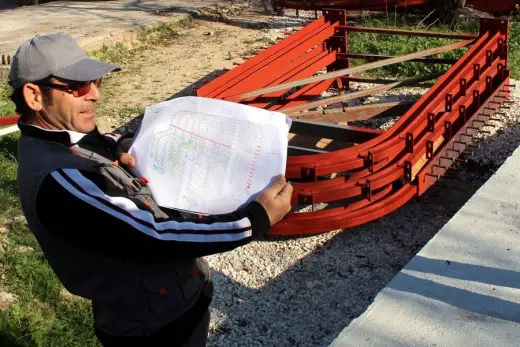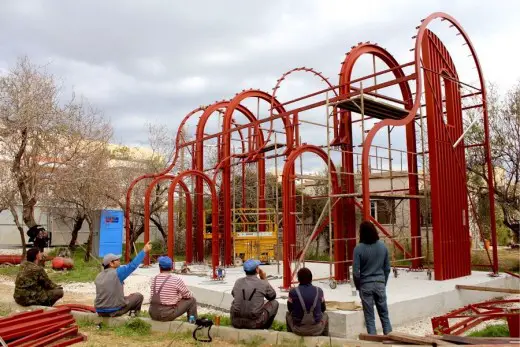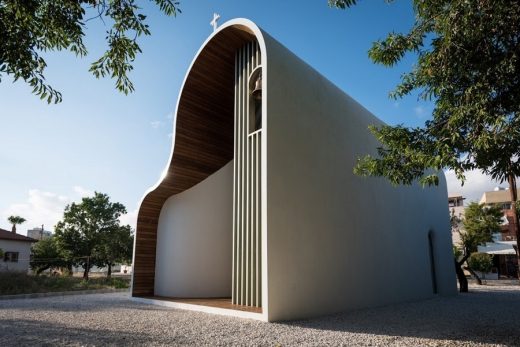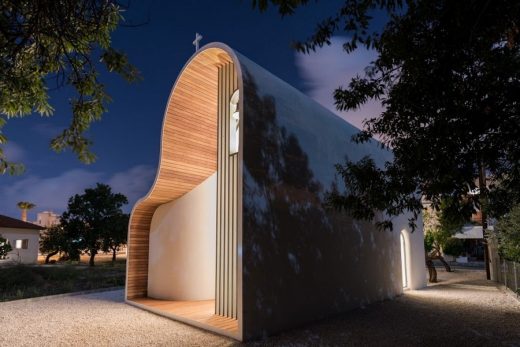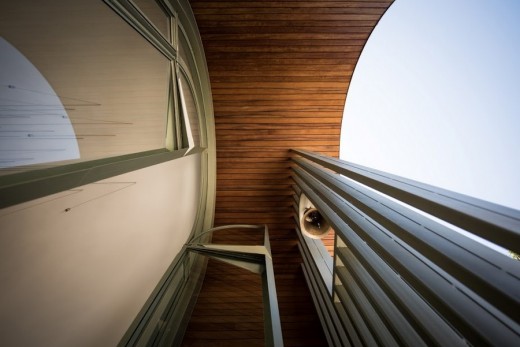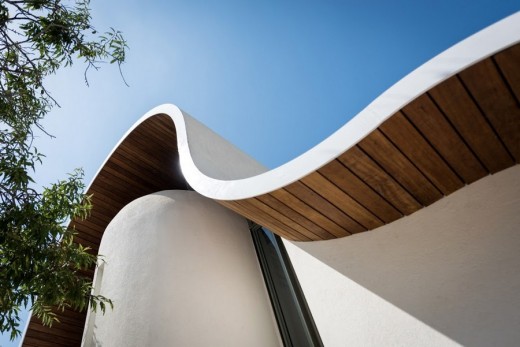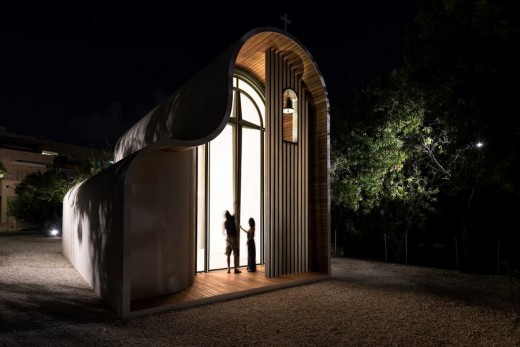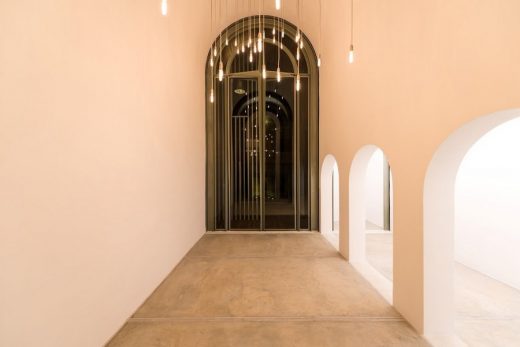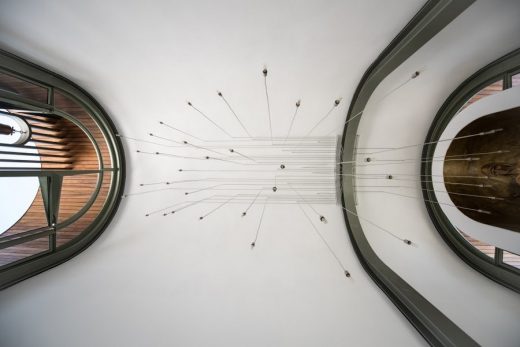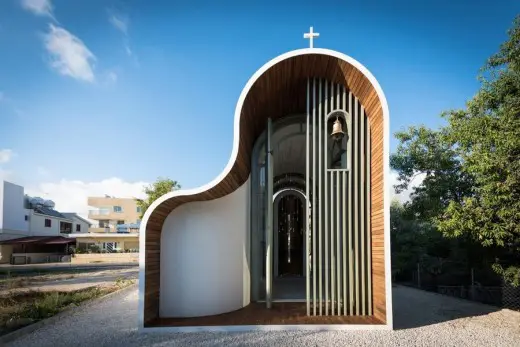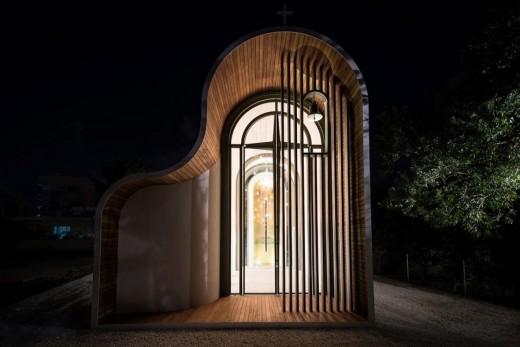Apostle Peter and St Helen the Martyr Chapel, New Pafos Building, Design Cyprus, Images
Apostle Peter and St Helen the Martyr Chapel, Pafos
Cypriot Place of Worship design by Parametric Design
8 Oct 2015
Apostle Peter and St Helen the Martyr Chapel in Pafos
Design: Parametric Design
Location: Pafos, Cyprus
The Greek Orthodox chapel commemorating Apostle Peter and St. Helen the Martyr is situated on Kerkiras Street, in St. Theodoros area in Pafos, Cyprus. The founding stone was placed by the Bishop of Pafos, Georgios IV, on Saturday 7th December 2013 and the project was completed on Sunday 19th July 2015.
The chapel typology belongs to the double-aisle vaulted orthodox temples. The building program includes a Narthex, a Nave, a side Aisle, a Sanctuary and a Prothesis.
Morphologically, it is inspired by the local orthodox ecclesiastical architecture, while, through a series of innovative building methods and materials, it presents a contemporary example.
As such, the entire chapel is formed by extruding a section along a longitudinal axis which results in a legible, lightweight and welcoming form. The east and west sides of the extruded form are left open providing covered spaces filtering daylight and views.
The interaction of the extrusion with the programmatic elements of the building creates complex moments and rich spaces within the shell. As such, the side aisle appears as a solid volume that communicates with the central Nave through a series of consecutive arches. On the east side, a semi-cylindrical, self-standing element hosting the sanctuary is inserted in the shell.
On the west, vertical louvers, forming the bell-tower, provide shading for the entrance of the chapel while a large 5.5-meter-tall door allows the interior to be merged with the exterior. Finally, the landscape, identified by the almond trees complements the synthesis.
The Sanctuary Mural and the Iconostasis are emphasized by the filtered entrance light, which penetrates the longitudinal interior of the Chapel. The cupola of the Sanctuary features Virgin Mary and baby Christ, surrounded and celebrated by Seraphim and Cherubim.
The figures are highlighted by the highly detailed textile folds and the large spectrum of golden shades. The composition is complemented by elaborated geometric ornaments. The Iconostasis holds the Icons of Christ, Virgin Mary, Apostle Peter and St. Helen, while allowing selected views to the mural of the Sanctuary through a number of small openings.
Design Approach
The chapel presented a design challenge as it called for innovation on a morphologically and structurally constrained building typology. The project abandons the traditional design methods by introducing a core collaborative approach within the design team to bridge complexity and affordability. As opposed to the standard design procedures, a body of multi-disciplinary collective knowledge was gathered early on and employed throughout the entire duration of the project.
Architecture, structure and cost became parts of an integrated design process which was handled using high-end digital tools since the very early stages of the design. These tools enhanced collaboration between individual disciplines and enabled the development of efficient construction workflows.
Construction Technology
In terms of construction technology, the designers integrated existing and reinvented materials with high-end computational tools and methods to introduce new means of realizing complex forms.
The team specified the use of Ferrocement, a concrete based thin-wall composite used in the 60’s for constructing thin, free-form shell structures and floating vessels. Its lightweight nature and the formwork-free application rendered it appropriate for the above applications. Despite its significant features, Ferrocement has been surpassed by modern construction methods and materials, mainly due to its labor-intensive nature and the difficulty to be incorporated in modern (yet conservative) Building Regulations and Codes of Standards.
As such, Ferrocement had been left aside and would only be utilized in low-expertise, non-structural applications for quite a long time. Understanding the potential of the material, the design team proposed the modernization of the technique in order to be applied in the construction of the Chapel.
The constructability and capacity of Ferocement were tested locally with a series of lab and field tests, revealing its advantageous properties. The material featured high capacity and durability combined with high flexibility in free-form adaptation.
The disadvantage of labor intensive application was mitigated by the use of contemporary digital practices presenting precision and cost benefits. An exceptionally thin, yet rigid, Ferrocement shell combined with a steel structural frame and reinforced concrete walls was successfully constructed, forming the composite structural system of the chapel.
The integrated properties of the composite system enabled a shell thickness of as low as 70 mm, including thermal insulation. The combination with modern construction materials allowed Ferrocement to be re-considered as a competitive alternative in current complex construction applications.
Digital design tools and methods enabled a seamless collaboration both internally (within the design team) and externally (with the contractors). A bi-directional computational definition associated structural simulations, construction details, cost and CAD/CAM information. Consequently, most of the communication was performed digitally, eliminating errors, reducing cost and increasing design and construction speed.
In addition, investing in digital fabrication enabled the team to push for higher finishing quality while remaining within budget. As such, formwork parts, a range of building elements, lighting fixtures and even fixed furniture were developed and sent for fabrication directly from the design team, facilitating complex construction tasks.
Apostle Peter and St Helen the Martyr Chapel – Building Information
Project Name: Apostle Peter and St. Helen the Martyr Chapel
Type: Religious
Location: Pafos, Cyprus, 34°77’29.449″N 32° 43’52.93″E
Date Finished: July 2015
Area: 56m²
Volume: 290m³
Design Team:
Architect: Michail Georgiou
Architectural Design: Michail Georgiou, Theresa Kwok
Structural Design: Odysseas Georgiou (www.odysseasgeorgiou.com)
Quantity Surveyor: Danae Kynigou
Mechanical Engineer: Savvas Leonidou
Lighting Design: Kyriaki Pafitou
Artist: Konstandinos Zannetos
Contractor: A. Ioannou Constructions LTD
Metal Contractor: Makico Metal Contractors LTD
Owner/Sponsor: Petros and Elli Georgiou
Photographs: Charis Solomou (http://500px.com/charisarch)
Figures and CS Photographs: Michalis Georgiou and Odysseas Georgiou
Apostle Peter and St Helen the Martyr Chapel images / information from Parametric Design
Location: Pafos ,Cyprus, southeast Europe
Cyprus Architecture
Contemporary Cypriot Architectural Projects
Cypriot Architecture Design – chronological list
Cypriot Buildings
Nicosia Residence
Polytia Architects

image from architect
Nicosia Residence
University of Cyprus Campus, Nicosia
BM3 Architecture
University of Cyprus Building
Gladstonos 22, Nicosia
Theo David Architects
Nicosia Residential Building
Developments in countries close to Cyprus
Comments / photos for the Apostle Peter and St Helen the Martyr Chapel in Pafos – New Cyprus Architecture by Parametric Design page welcome

